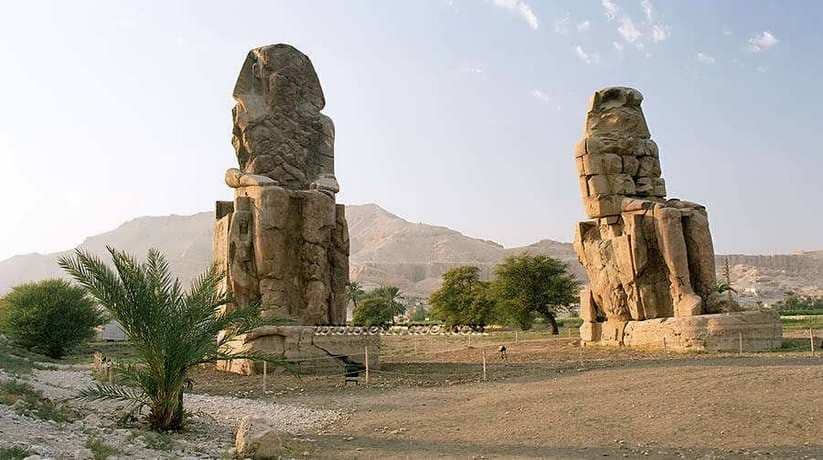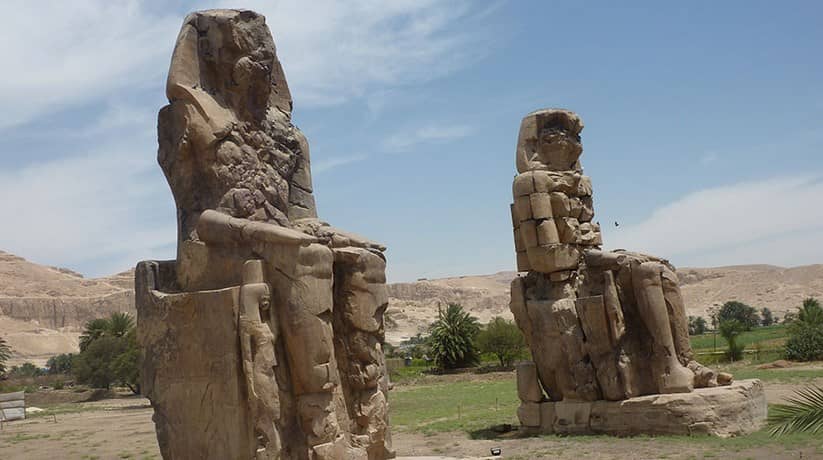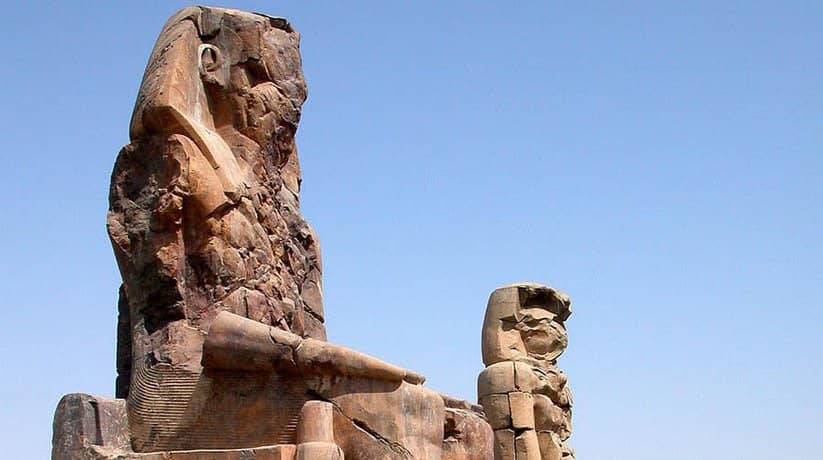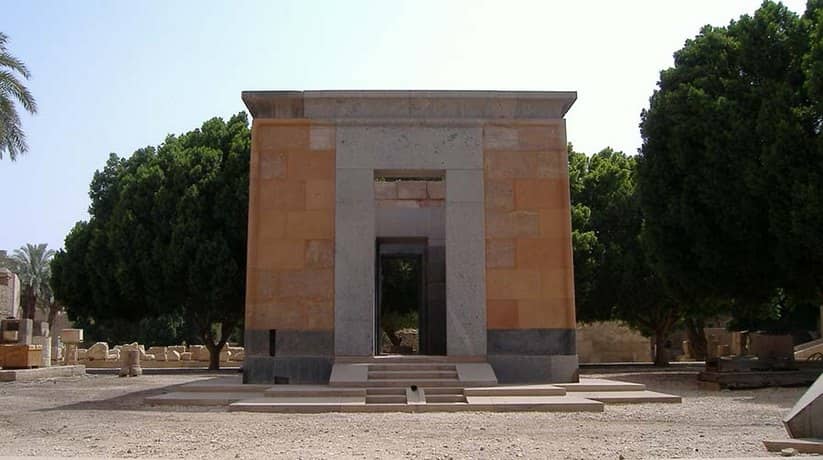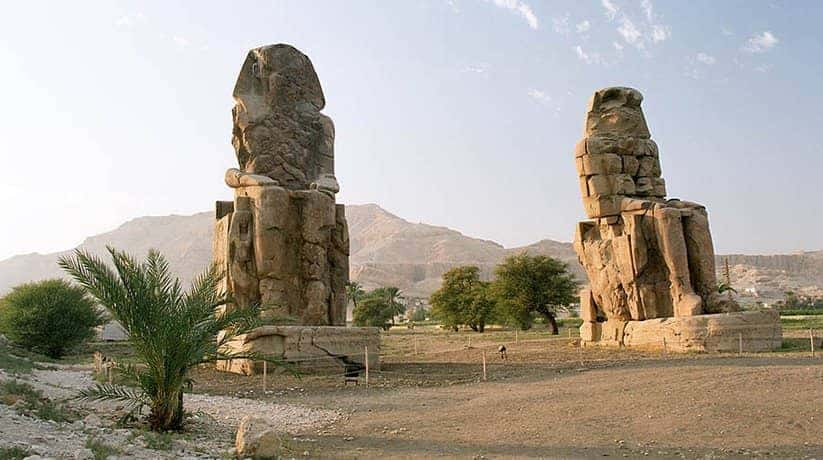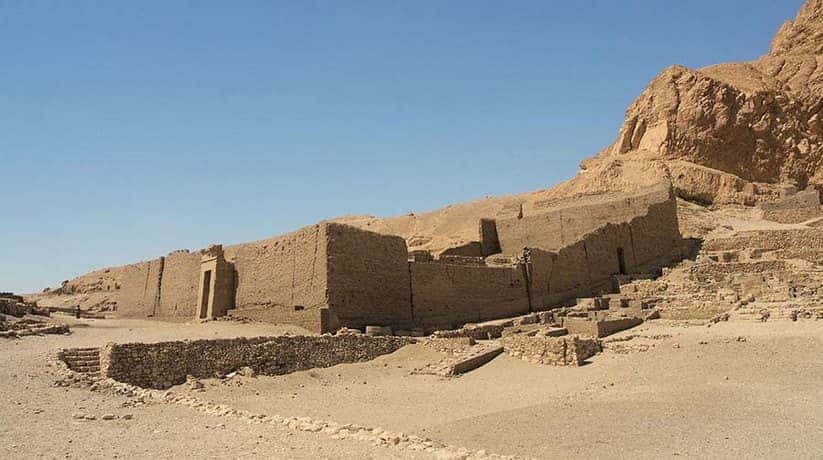Other Ancient Luxor Egypt tours, booking, prices, reviews
Colossi of Memnon are an example of other Ancient Luxor which you can see. are two gigantic stone statues. They known as Colossi of Memnon since 1350 BC. In fact, Colossi of Memnon guard the temple of Pharaoh Amenhotep III. It is where worshiped as a god-on-earth both before and after his departure from this world. Moreover, the massive statues, each about 20 meters high resemble Amenhotep III himself. They got their name after one of the statues, the right one to the north damaged in an earthquake. Colossi of Memnon are not the only massive statues of Pharaoh Amenhotep. In fact, in 2014, archaeologists unearthed two more statues of the pharaoh. The new statues of the pharaoh join a pair of already famous giants. It is at the temple which known as the Colossi of Memnon.
Deir El Medina is also a good example of other Ancient Luxor. It is the Arabic name for the village in the Theban necropolis. In fact, Deir El Medina once occupied by the pharaohs’ tomb builders. It also occupied by the artisans of New Kingdom Thebes. It’s name means “Monastery of the Town”. In fact, it derives from the Coptic monks who occupied the Ptolemaic temple there. It was during the early Christian period. In ancient times Deir El Medina known as “Set Ma’at” (the Place of Truth) or “Pa-demi” (the town). We do not know exactly when Deir El Medina founded. Bricks discovered in the original enclosure wall stamped with Thutmose I name. It is although Queen Ahmose-Nefertari and her son Amenhotep I revered by the inhabitants. They are of early Dynasty XVIII.
Further details about the other Ancient Luxor Egypt:
Hatshepsut Red Chapel is also a good example of other Ancient Luxor. In fact, it was a barque shrine and the White Chapel of Senusret I. Furthermore, The Red Chapel built with a base and doorways of black granite. It is also with walls of red quartzite, from the quarry which known as Gebel Ahmar, or “Red Mountain”. Of course, the latter stone explains why the shrine known the Red Chapel. In fact, the natural color of the red quartzite varies. Therefor, the ancient craftsman painted all the block a uniform red color. It begun about four years before Hatshepsut’s death in about 1483 BC. Her nephew and successor Thutmose III maybe continued work on the chapel. But in fact, it never finished.
Hot Air Balloon ride is also another example of other Ancient Luxor. The balloon ride in the early morning indeed is one of the most breathtaking ways to see Luxor. The sunrise view you’ll catch while floating up in the clouds is worth waking up early. Moreover, the way the sun hits the magnificent temples. It lights up the green of the Nile banks is a sight you will never forget. Furthermore, there are many balloon companies you can arrange a trip with. They are subject to rigid security regulations. A hot air balloon is an incredible way to see the “world’s largest open air museum”. Moreover, there will be an early pickup at your hotel. And then, we will take you to the balloon. The balloon will carry over Luxor’s ruins and temples in the beautiful morning light.
More details about the city:
Medinet Habu or city of Habu is also a good example of other Ancient Luxor. In fact, the site located in the west bank in Luxor. The ancient Egyptian name of the site was Djamet. It means meaning males and mothers. Its holy ground believed to be where the Ogdoad, the four pairs of first primeval gods buried. The city of Habu was both a temple and a complex of temples. It dates back to the New Kingdom. It adjoins the cultivation at the southern end of the Theban necropolis. The area was one of the earliest places within the Theban region to associated with the worship of Amun. The Hatshepsut and Thutmose III built a small temple to Amun on the site of an earlier structure. Next to their temple, Ramses III built his mortuary temple. It is Medinet Habu Luxor’s most conspicuous standing monument.
The Valley of the Kings necropolis is also a great example of other Ancient Luxor. It located in the west bank in Luxor, Egypt. In fact, the valley of the Kings is an area for tombs. The tombs built for the Pharaohs and powerful nobles of the New Kingdom of Ancient Egypt. In fact the Ancient Egypt religion based on the cult of death. It also based on the lifelong preparation for the afterlife. The Valley of the Kings in the West Bank necropolis is a mute testimony to this obsession. The pharaohs buried in secret tombs here and protected by the best security of the age. Few burial sites escaped the plundering of grave robbers.
Further details about the city:
The Valley of the Kings created and used from 1539 BC to 1075 BC. It contains about 60 tombs, starting with Thutmose I and ending with Ramses X or XI. The official name of the site was The Great and Majestic Necropolis of the Millions of Years of the Pharaoh. The Valley of the Kings also had tombs for the favorite nobles and the wives. It also had children of both the nobles and pharaohs. Around the time of Ramses I 1300 BC, they start to build the Valley of the Queens. In fact some wives still buried with their husbands at the Valley of Kings.
The Valley of the Queens is also another great example of the Other Ancient Luxor. In fact, the valley lies southwest of the village and temples of Medinet Habu. It is roughly 500 meters west of Deir El Medina, on the west bank of the Nile. In fact, the Valley of the Queens hidden in a Y-shaped ravine in the western cliffs. Moreover, the Valley of the Queens served as a necropolis for the tombs of Royal Family members. It also did for the elite. Furthermore, the Valley of the Queens has about 90 numbered tombs. In fact, the tombs belong to queens, princes, and high officials of the New Kingdom. The New Kingdom was from 1550 to 1070 BC. The location of the Valley of the Queens chosen indeed carefully.
More details about the other Ancient Luxor Egypt:
In fact, it contributed to its magical atmosphere. It also contributed in the association with the great mother goddess Hathor. During the 18th Dynasty (1550 – 1295 BC), high officials chose to bury in the valley. The first member of the Royal Family to was Sitre (QV 38). In fact, she was the wife of Ramses I of the 19th Dynasty (1295 – 1294 BC). By the end of the reign of Ramses III, the Valley of the Queens seen extensive use. During the Third Intermediate Period, some tombs reused and modified. Finally, during the Roman Period (30 BC – 364 AD), the tombs again reused for the burial of animal mummies. Many of the tombs in the Valley of the Queens fell victim to robbery in antiquity. The late New Kingdom Abbott Papyrus is now in the British Museum.

